E-commerce Systems: The Impact of Consumer Preference on Growth
VerifiedAdded on 2023/06/11
|16
|4676
|454
Report
AI Summary
This report explores the critical role of consumer preference in the growth and success of e-commerce systems. It begins by outlining the research questions and methodology, focusing on understanding consumer behavior and its influence on online market performance. The introduction highlights the rise of internet-based virtual stores and the importance of online marketing. It addresses concerns related to current e-business policies, including consumer trust and satisfaction. The report further examines the impact of e-commerce on purchase decisions, the use of social media for marketing, and factors such as convenience and brand widening. It also proposes measures to improve website reaction speed, image integrity, and payment system security. The conclusion emphasizes the significance of consumer behavior in driving e-business growth.

Running head: E-COMMERCE SYSTEMS
E-commerce systems
Name of the student:
Name of the University:
Author note
E-commerce systems
Name of the student:
Name of the University:
Author note
Paraphrase This Document
Need a fresh take? Get an instant paraphrase of this document with our AI Paraphraser
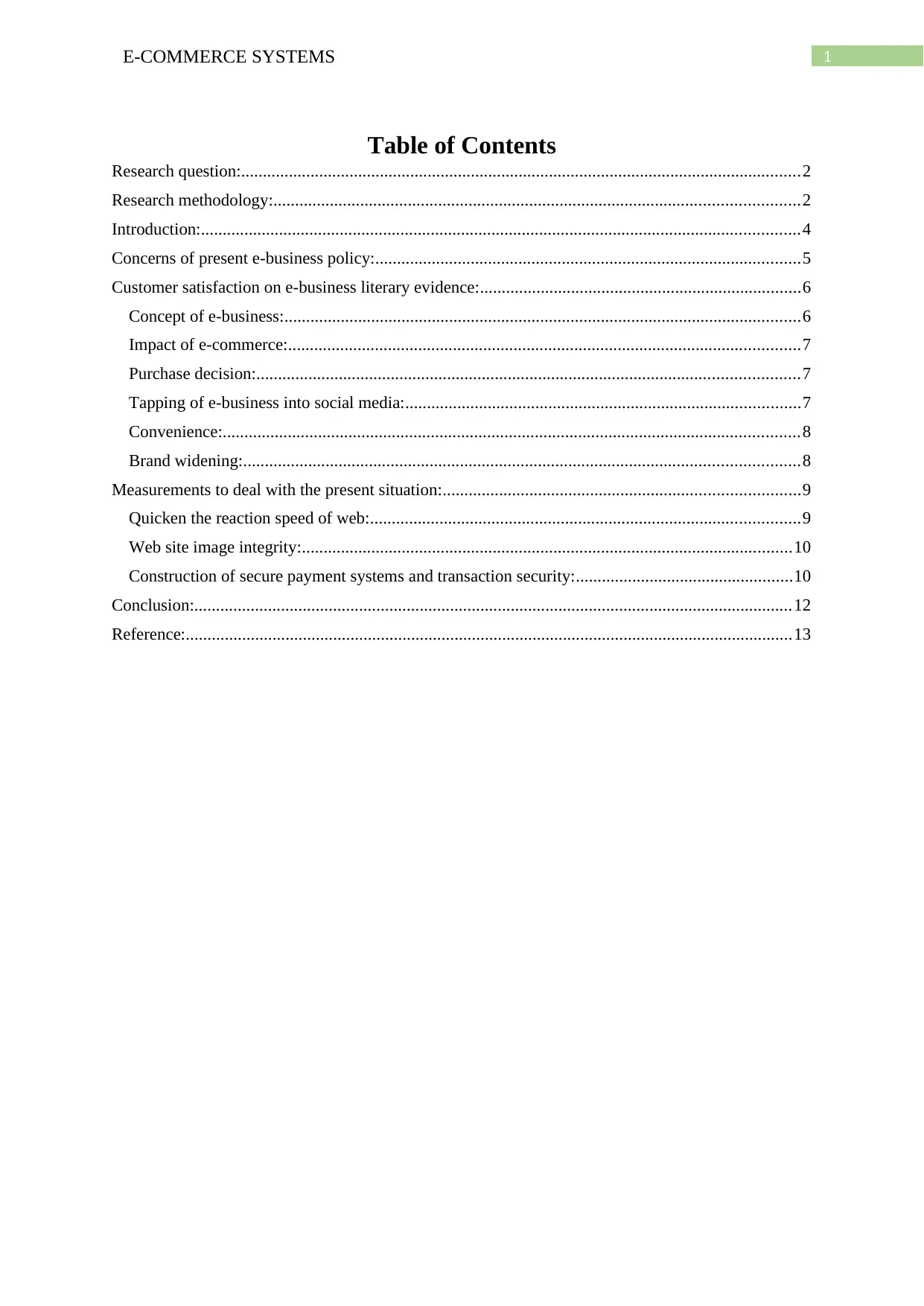
1E-COMMERCE SYSTEMS
Table of Contents
Research question:.................................................................................................................................2
Research methodology:.........................................................................................................................2
Introduction:..........................................................................................................................................4
Concerns of present e-business policy:..................................................................................................5
Customer satisfaction on e-business literary evidence:..........................................................................6
Concept of e-business:.......................................................................................................................6
Impact of e-commerce:......................................................................................................................7
Purchase decision:.............................................................................................................................7
Tapping of e-business into social media:...........................................................................................7
Convenience:.....................................................................................................................................8
Brand widening:................................................................................................................................8
Measurements to deal with the present situation:..................................................................................9
Quicken the reaction speed of web:...................................................................................................9
Web site image integrity:.................................................................................................................10
Construction of secure payment systems and transaction security:..................................................10
Conclusion:..........................................................................................................................................12
Reference:............................................................................................................................................13
Table of Contents
Research question:.................................................................................................................................2
Research methodology:.........................................................................................................................2
Introduction:..........................................................................................................................................4
Concerns of present e-business policy:..................................................................................................5
Customer satisfaction on e-business literary evidence:..........................................................................6
Concept of e-business:.......................................................................................................................6
Impact of e-commerce:......................................................................................................................7
Purchase decision:.............................................................................................................................7
Tapping of e-business into social media:...........................................................................................7
Convenience:.....................................................................................................................................8
Brand widening:................................................................................................................................8
Measurements to deal with the present situation:..................................................................................9
Quicken the reaction speed of web:...................................................................................................9
Web site image integrity:.................................................................................................................10
Construction of secure payment systems and transaction security:..................................................10
Conclusion:..........................................................................................................................................12
Reference:............................................................................................................................................13
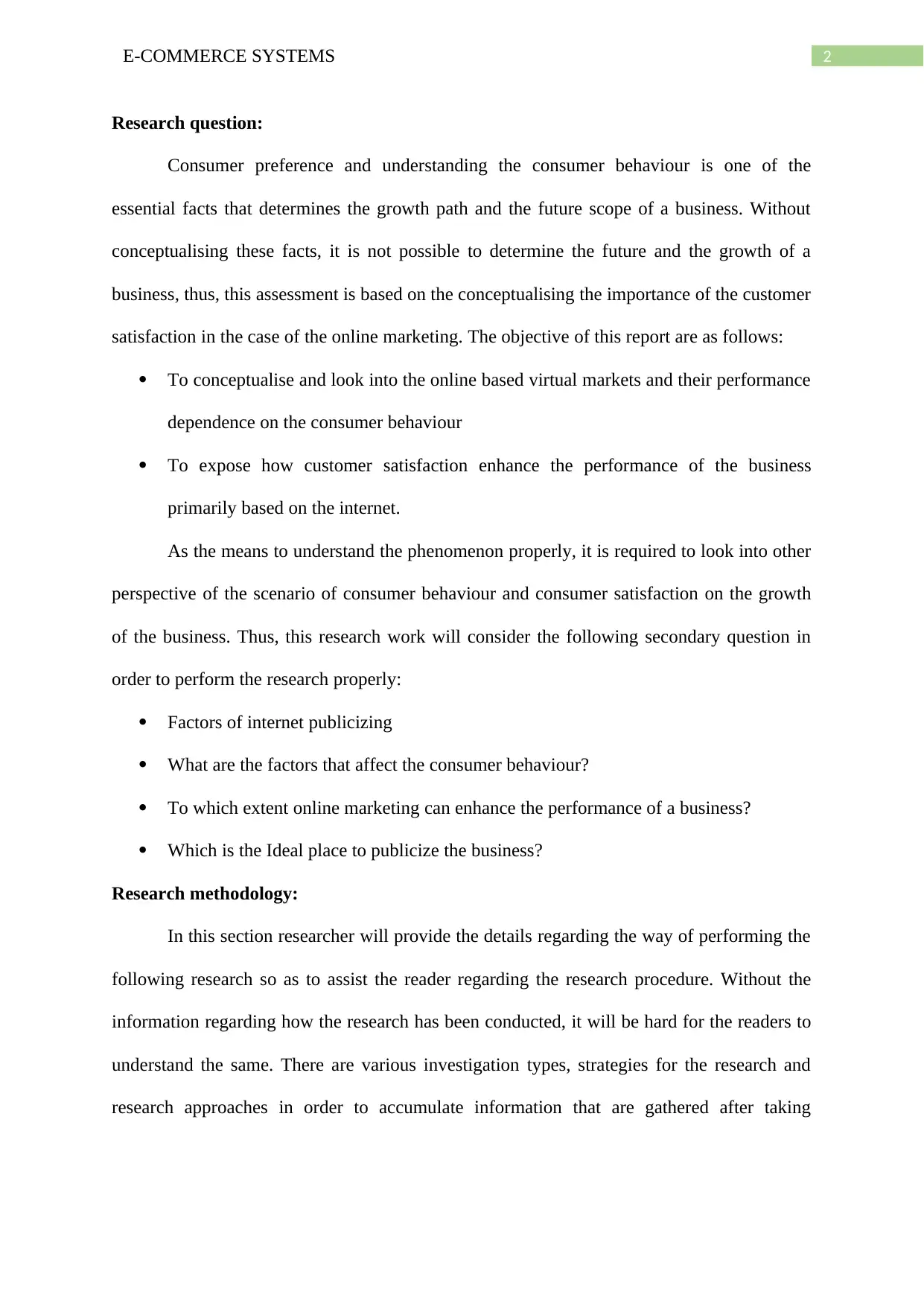
2E-COMMERCE SYSTEMS
Research question:
Consumer preference and understanding the consumer behaviour is one of the
essential facts that determines the growth path and the future scope of a business. Without
conceptualising these facts, it is not possible to determine the future and the growth of a
business, thus, this assessment is based on the conceptualising the importance of the customer
satisfaction in the case of the online marketing. The objective of this report are as follows:
To conceptualise and look into the online based virtual markets and their performance
dependence on the consumer behaviour
To expose how customer satisfaction enhance the performance of the business
primarily based on the internet.
As the means to understand the phenomenon properly, it is required to look into other
perspective of the scenario of consumer behaviour and consumer satisfaction on the growth
of the business. Thus, this research work will consider the following secondary question in
order to perform the research properly:
Factors of internet publicizing
What are the factors that affect the consumer behaviour?
To which extent online marketing can enhance the performance of a business?
Which is the Ideal place to publicize the business?
Research methodology:
In this section researcher will provide the details regarding the way of performing the
following research so as to assist the reader regarding the research procedure. Without the
information regarding how the research has been conducted, it will be hard for the readers to
understand the same. There are various investigation types, strategies for the research and
research approaches in order to accumulate information that are gathered after taking
Research question:
Consumer preference and understanding the consumer behaviour is one of the
essential facts that determines the growth path and the future scope of a business. Without
conceptualising these facts, it is not possible to determine the future and the growth of a
business, thus, this assessment is based on the conceptualising the importance of the customer
satisfaction in the case of the online marketing. The objective of this report are as follows:
To conceptualise and look into the online based virtual markets and their performance
dependence on the consumer behaviour
To expose how customer satisfaction enhance the performance of the business
primarily based on the internet.
As the means to understand the phenomenon properly, it is required to look into other
perspective of the scenario of consumer behaviour and consumer satisfaction on the growth
of the business. Thus, this research work will consider the following secondary question in
order to perform the research properly:
Factors of internet publicizing
What are the factors that affect the consumer behaviour?
To which extent online marketing can enhance the performance of a business?
Which is the Ideal place to publicize the business?
Research methodology:
In this section researcher will provide the details regarding the way of performing the
following research so as to assist the reader regarding the research procedure. Without the
information regarding how the research has been conducted, it will be hard for the readers to
understand the same. There are various investigation types, strategies for the research and
research approaches in order to accumulate information that are gathered after taking
⊘ This is a preview!⊘
Do you want full access?
Subscribe today to unlock all pages.

Trusted by 1+ million students worldwide
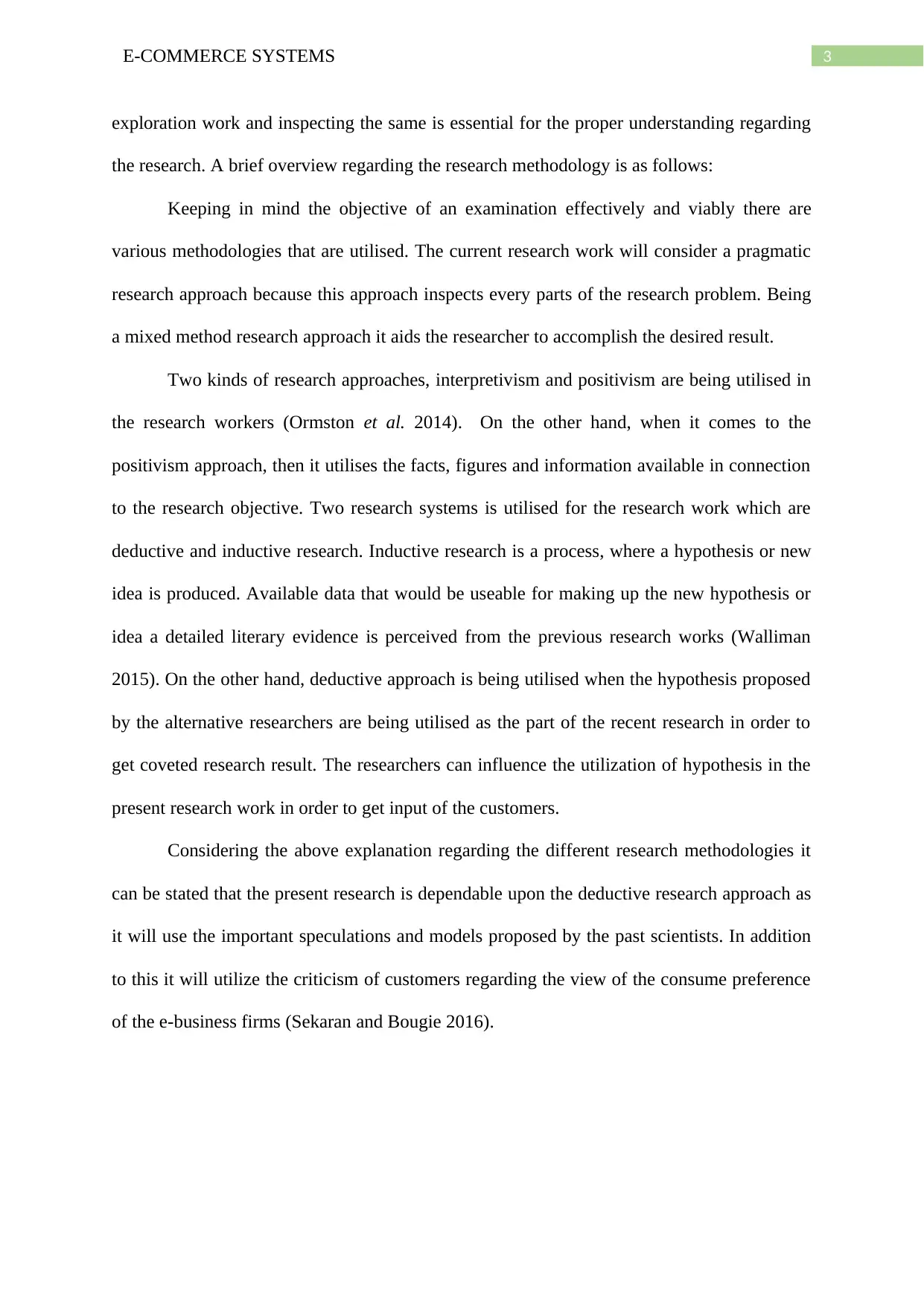
3E-COMMERCE SYSTEMS
exploration work and inspecting the same is essential for the proper understanding regarding
the research. A brief overview regarding the research methodology is as follows:
Keeping in mind the objective of an examination effectively and viably there are
various methodologies that are utilised. The current research work will consider a pragmatic
research approach because this approach inspects every parts of the research problem. Being
a mixed method research approach it aids the researcher to accomplish the desired result.
Two kinds of research approaches, interpretivism and positivism are being utilised in
the research workers (Ormston et al. 2014). On the other hand, when it comes to the
positivism approach, then it utilises the facts, figures and information available in connection
to the research objective. Two research systems is utilised for the research work which are
deductive and inductive research. Inductive research is a process, where a hypothesis or new
idea is produced. Available data that would be useable for making up the new hypothesis or
idea a detailed literary evidence is perceived from the previous research works (Walliman
2015). On the other hand, deductive approach is being utilised when the hypothesis proposed
by the alternative researchers are being utilised as the part of the recent research in order to
get coveted research result. The researchers can influence the utilization of hypothesis in the
present research work in order to get input of the customers.
Considering the above explanation regarding the different research methodologies it
can be stated that the present research is dependable upon the deductive research approach as
it will use the important speculations and models proposed by the past scientists. In addition
to this it will utilize the criticism of customers regarding the view of the consume preference
of the e-business firms (Sekaran and Bougie 2016).
exploration work and inspecting the same is essential for the proper understanding regarding
the research. A brief overview regarding the research methodology is as follows:
Keeping in mind the objective of an examination effectively and viably there are
various methodologies that are utilised. The current research work will consider a pragmatic
research approach because this approach inspects every parts of the research problem. Being
a mixed method research approach it aids the researcher to accomplish the desired result.
Two kinds of research approaches, interpretivism and positivism are being utilised in
the research workers (Ormston et al. 2014). On the other hand, when it comes to the
positivism approach, then it utilises the facts, figures and information available in connection
to the research objective. Two research systems is utilised for the research work which are
deductive and inductive research. Inductive research is a process, where a hypothesis or new
idea is produced. Available data that would be useable for making up the new hypothesis or
idea a detailed literary evidence is perceived from the previous research works (Walliman
2015). On the other hand, deductive approach is being utilised when the hypothesis proposed
by the alternative researchers are being utilised as the part of the recent research in order to
get coveted research result. The researchers can influence the utilization of hypothesis in the
present research work in order to get input of the customers.
Considering the above explanation regarding the different research methodologies it
can be stated that the present research is dependable upon the deductive research approach as
it will use the important speculations and models proposed by the past scientists. In addition
to this it will utilize the criticism of customers regarding the view of the consume preference
of the e-business firms (Sekaran and Bougie 2016).
Paraphrase This Document
Need a fresh take? Get an instant paraphrase of this document with our AI Paraphraser
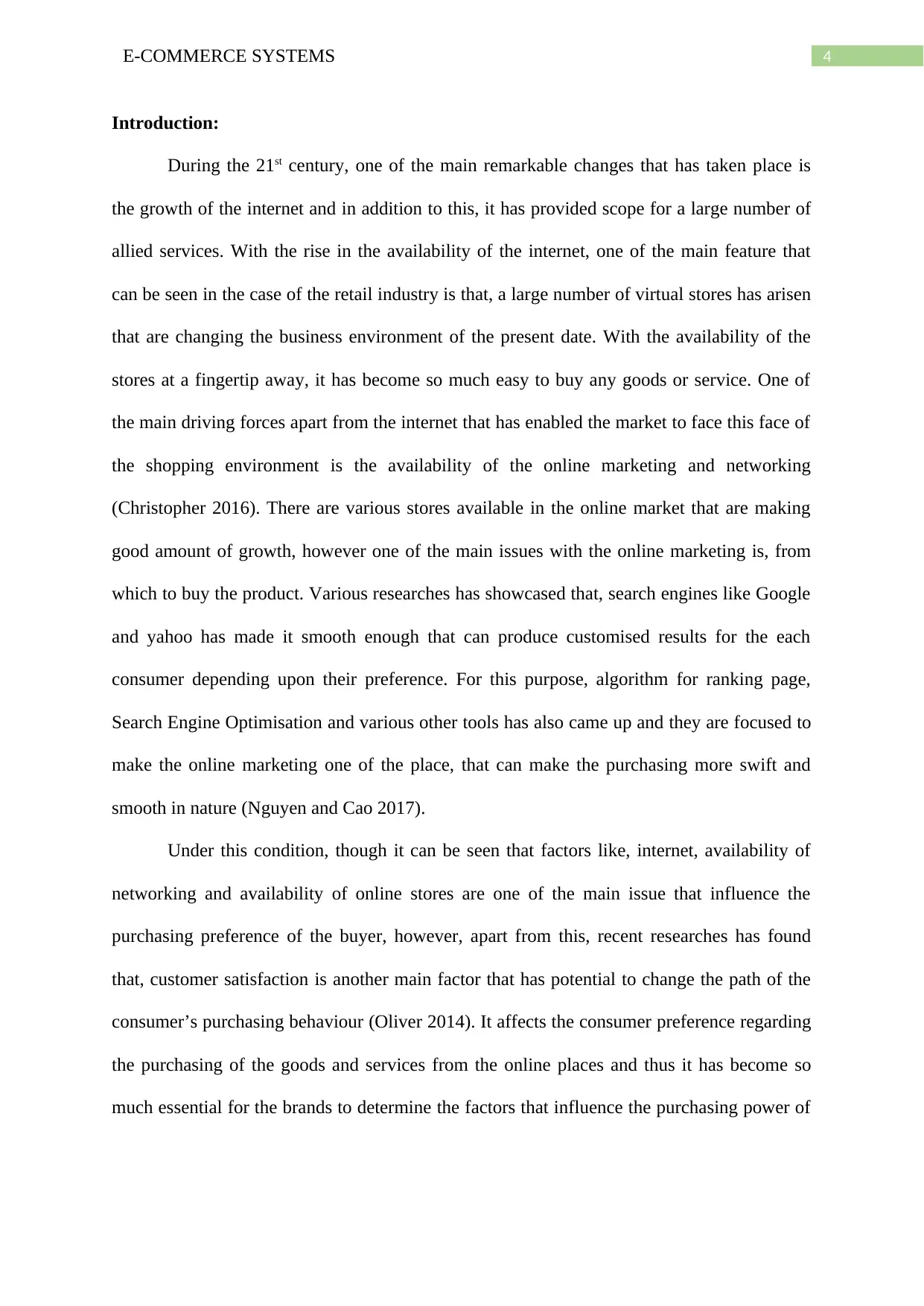
4E-COMMERCE SYSTEMS
Introduction:
During the 21st century, one of the main remarkable changes that has taken place is
the growth of the internet and in addition to this, it has provided scope for a large number of
allied services. With the rise in the availability of the internet, one of the main feature that
can be seen in the case of the retail industry is that, a large number of virtual stores has arisen
that are changing the business environment of the present date. With the availability of the
stores at a fingertip away, it has become so much easy to buy any goods or service. One of
the main driving forces apart from the internet that has enabled the market to face this face of
the shopping environment is the availability of the online marketing and networking
(Christopher 2016). There are various stores available in the online market that are making
good amount of growth, however one of the main issues with the online marketing is, from
which to buy the product. Various researches has showcased that, search engines like Google
and yahoo has made it smooth enough that can produce customised results for the each
consumer depending upon their preference. For this purpose, algorithm for ranking page,
Search Engine Optimisation and various other tools has also came up and they are focused to
make the online marketing one of the place, that can make the purchasing more swift and
smooth in nature (Nguyen and Cao 2017).
Under this condition, though it can be seen that factors like, internet, availability of
networking and availability of online stores are one of the main issue that influence the
purchasing preference of the buyer, however, apart from this, recent researches has found
that, customer satisfaction is another main factor that has potential to change the path of the
consumer’s purchasing behaviour (Oliver 2014). It affects the consumer preference regarding
the purchasing of the goods and services from the online places and thus it has become so
much essential for the brands to determine the factors that influence the purchasing power of
Introduction:
During the 21st century, one of the main remarkable changes that has taken place is
the growth of the internet and in addition to this, it has provided scope for a large number of
allied services. With the rise in the availability of the internet, one of the main feature that
can be seen in the case of the retail industry is that, a large number of virtual stores has arisen
that are changing the business environment of the present date. With the availability of the
stores at a fingertip away, it has become so much easy to buy any goods or service. One of
the main driving forces apart from the internet that has enabled the market to face this face of
the shopping environment is the availability of the online marketing and networking
(Christopher 2016). There are various stores available in the online market that are making
good amount of growth, however one of the main issues with the online marketing is, from
which to buy the product. Various researches has showcased that, search engines like Google
and yahoo has made it smooth enough that can produce customised results for the each
consumer depending upon their preference. For this purpose, algorithm for ranking page,
Search Engine Optimisation and various other tools has also came up and they are focused to
make the online marketing one of the place, that can make the purchasing more swift and
smooth in nature (Nguyen and Cao 2017).
Under this condition, though it can be seen that factors like, internet, availability of
networking and availability of online stores are one of the main issue that influence the
purchasing preference of the buyer, however, apart from this, recent researches has found
that, customer satisfaction is another main factor that has potential to change the path of the
consumer’s purchasing behaviour (Oliver 2014). It affects the consumer preference regarding
the purchasing of the goods and services from the online places and thus it has become so
much essential for the brands to determine the factors that influence the purchasing power of
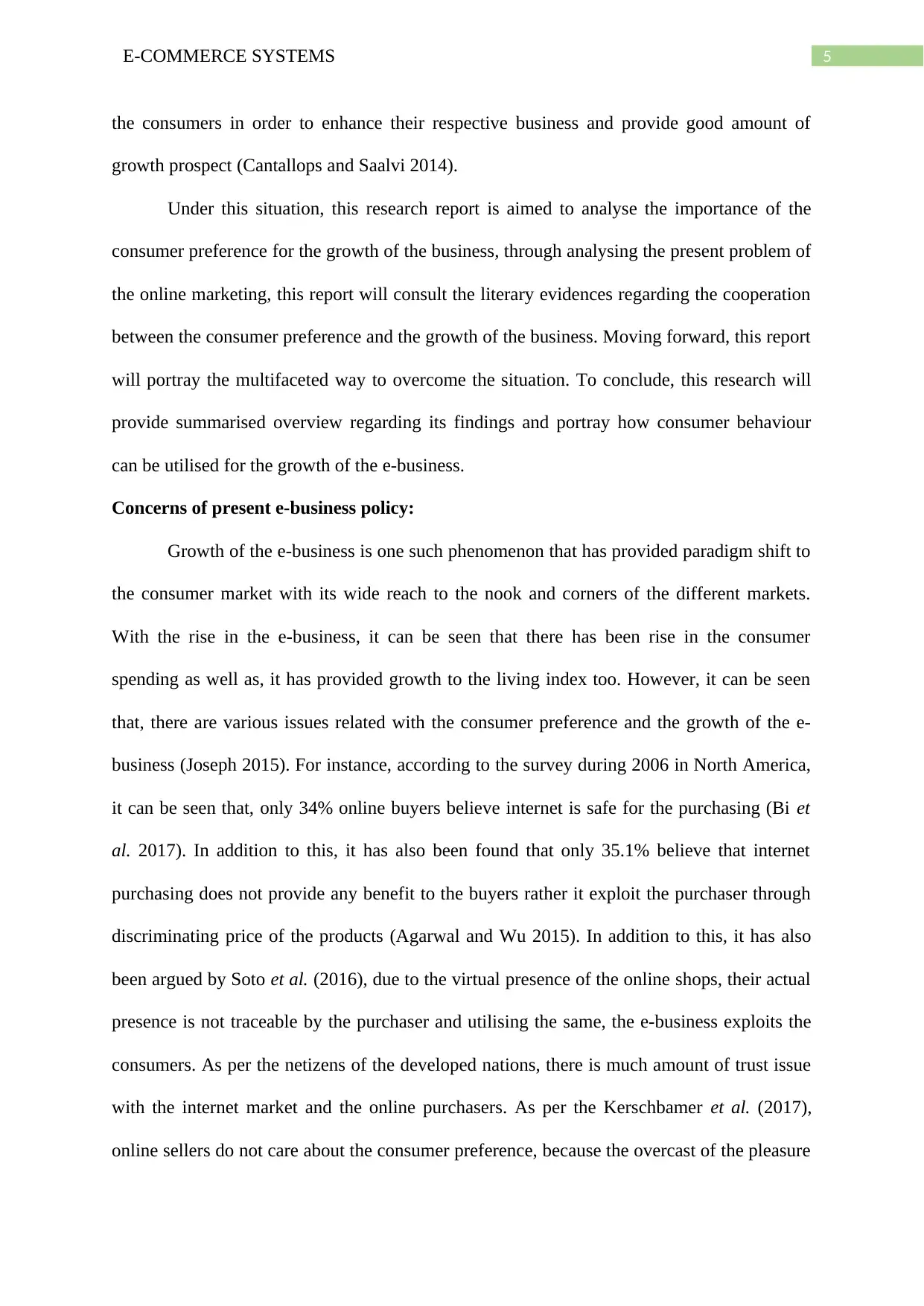
5E-COMMERCE SYSTEMS
the consumers in order to enhance their respective business and provide good amount of
growth prospect (Cantallops and Saalvi 2014).
Under this situation, this research report is aimed to analyse the importance of the
consumer preference for the growth of the business, through analysing the present problem of
the online marketing, this report will consult the literary evidences regarding the cooperation
between the consumer preference and the growth of the business. Moving forward, this report
will portray the multifaceted way to overcome the situation. To conclude, this research will
provide summarised overview regarding its findings and portray how consumer behaviour
can be utilised for the growth of the e-business.
Concerns of present e-business policy:
Growth of the e-business is one such phenomenon that has provided paradigm shift to
the consumer market with its wide reach to the nook and corners of the different markets.
With the rise in the e-business, it can be seen that there has been rise in the consumer
spending as well as, it has provided growth to the living index too. However, it can be seen
that, there are various issues related with the consumer preference and the growth of the e-
business (Joseph 2015). For instance, according to the survey during 2006 in North America,
it can be seen that, only 34% online buyers believe internet is safe for the purchasing (Bi et
al. 2017). In addition to this, it has also been found that only 35.1% believe that internet
purchasing does not provide any benefit to the buyers rather it exploit the purchaser through
discriminating price of the products (Agarwal and Wu 2015). In addition to this, it has also
been argued by Soto et al. (2016), due to the virtual presence of the online shops, their actual
presence is not traceable by the purchaser and utilising the same, the e-business exploits the
consumers. As per the netizens of the developed nations, there is much amount of trust issue
with the internet market and the online purchasers. As per the Kerschbamer et al. (2017),
online sellers do not care about the consumer preference, because the overcast of the pleasure
the consumers in order to enhance their respective business and provide good amount of
growth prospect (Cantallops and Saalvi 2014).
Under this situation, this research report is aimed to analyse the importance of the
consumer preference for the growth of the business, through analysing the present problem of
the online marketing, this report will consult the literary evidences regarding the cooperation
between the consumer preference and the growth of the business. Moving forward, this report
will portray the multifaceted way to overcome the situation. To conclude, this research will
provide summarised overview regarding its findings and portray how consumer behaviour
can be utilised for the growth of the e-business.
Concerns of present e-business policy:
Growth of the e-business is one such phenomenon that has provided paradigm shift to
the consumer market with its wide reach to the nook and corners of the different markets.
With the rise in the e-business, it can be seen that there has been rise in the consumer
spending as well as, it has provided growth to the living index too. However, it can be seen
that, there are various issues related with the consumer preference and the growth of the e-
business (Joseph 2015). For instance, according to the survey during 2006 in North America,
it can be seen that, only 34% online buyers believe internet is safe for the purchasing (Bi et
al. 2017). In addition to this, it has also been found that only 35.1% believe that internet
purchasing does not provide any benefit to the buyers rather it exploit the purchaser through
discriminating price of the products (Agarwal and Wu 2015). In addition to this, it has also
been argued by Soto et al. (2016), due to the virtual presence of the online shops, their actual
presence is not traceable by the purchaser and utilising the same, the e-business exploits the
consumers. As per the netizens of the developed nations, there is much amount of trust issue
with the internet market and the online purchasers. As per the Kerschbamer et al. (2017),
online sellers do not care about the consumer preference, because the overcast of the pleasure
⊘ This is a preview!⊘
Do you want full access?
Subscribe today to unlock all pages.

Trusted by 1+ million students worldwide
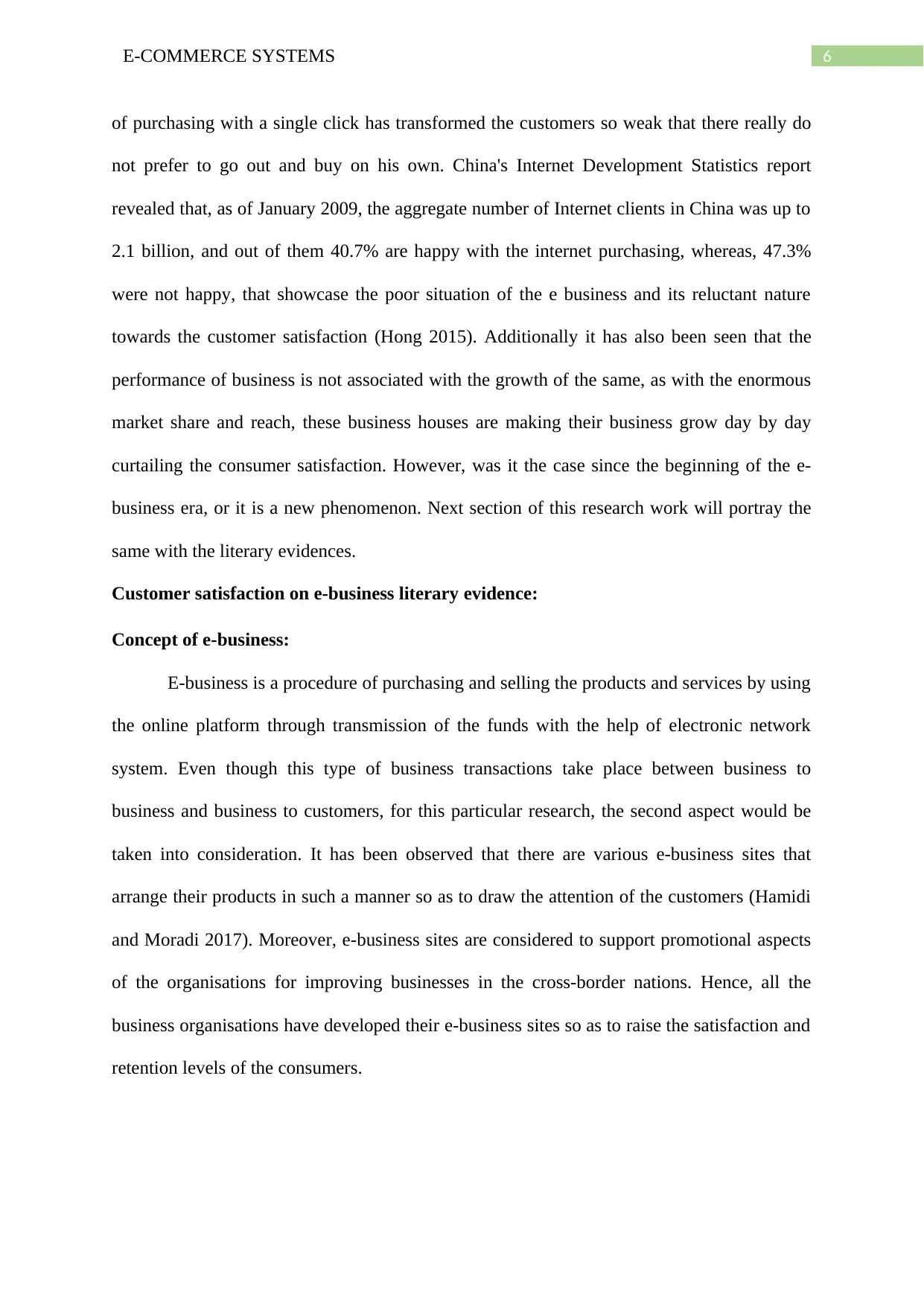
6E-COMMERCE SYSTEMS
of purchasing with a single click has transformed the customers so weak that there really do
not prefer to go out and buy on his own. China's Internet Development Statistics report
revealed that, as of January 2009, the aggregate number of Internet clients in China was up to
2.1 billion, and out of them 40.7% are happy with the internet purchasing, whereas, 47.3%
were not happy, that showcase the poor situation of the e business and its reluctant nature
towards the customer satisfaction (Hong 2015). Additionally it has also been seen that the
performance of business is not associated with the growth of the same, as with the enormous
market share and reach, these business houses are making their business grow day by day
curtailing the consumer satisfaction. However, was it the case since the beginning of the e-
business era, or it is a new phenomenon. Next section of this research work will portray the
same with the literary evidences.
Customer satisfaction on e-business literary evidence:
Concept of e-business:
E-business is a procedure of purchasing and selling the products and services by using
the online platform through transmission of the funds with the help of electronic network
system. Even though this type of business transactions take place between business to
business and business to customers, for this particular research, the second aspect would be
taken into consideration. It has been observed that there are various e-business sites that
arrange their products in such a manner so as to draw the attention of the customers (Hamidi
and Moradi 2017). Moreover, e-business sites are considered to support promotional aspects
of the organisations for improving businesses in the cross-border nations. Hence, all the
business organisations have developed their e-business sites so as to raise the satisfaction and
retention levels of the consumers.
of purchasing with a single click has transformed the customers so weak that there really do
not prefer to go out and buy on his own. China's Internet Development Statistics report
revealed that, as of January 2009, the aggregate number of Internet clients in China was up to
2.1 billion, and out of them 40.7% are happy with the internet purchasing, whereas, 47.3%
were not happy, that showcase the poor situation of the e business and its reluctant nature
towards the customer satisfaction (Hong 2015). Additionally it has also been seen that the
performance of business is not associated with the growth of the same, as with the enormous
market share and reach, these business houses are making their business grow day by day
curtailing the consumer satisfaction. However, was it the case since the beginning of the e-
business era, or it is a new phenomenon. Next section of this research work will portray the
same with the literary evidences.
Customer satisfaction on e-business literary evidence:
Concept of e-business:
E-business is a procedure of purchasing and selling the products and services by using
the online platform through transmission of the funds with the help of electronic network
system. Even though this type of business transactions take place between business to
business and business to customers, for this particular research, the second aspect would be
taken into consideration. It has been observed that there are various e-business sites that
arrange their products in such a manner so as to draw the attention of the customers (Hamidi
and Moradi 2017). Moreover, e-business sites are considered to support promotional aspects
of the organisations for improving businesses in the cross-border nations. Hence, all the
business organisations have developed their e-business sites so as to raise the satisfaction and
retention levels of the consumers.
Paraphrase This Document
Need a fresh take? Get an instant paraphrase of this document with our AI Paraphraser
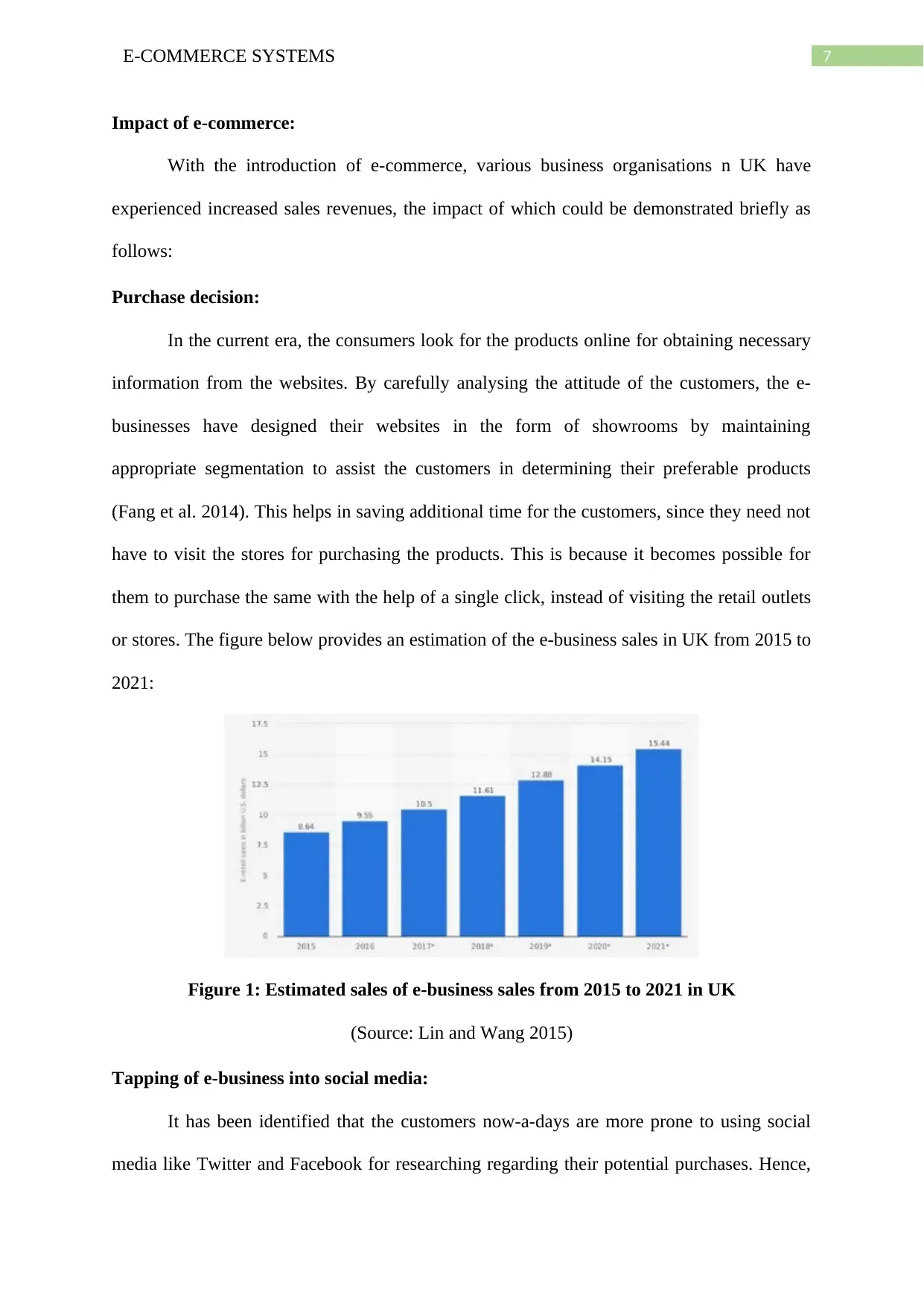
7E-COMMERCE SYSTEMS
Impact of e-commerce:
With the introduction of e-commerce, various business organisations n UK have
experienced increased sales revenues, the impact of which could be demonstrated briefly as
follows:
Purchase decision:
In the current era, the consumers look for the products online for obtaining necessary
information from the websites. By carefully analysing the attitude of the customers, the e-
businesses have designed their websites in the form of showrooms by maintaining
appropriate segmentation to assist the customers in determining their preferable products
(Fang et al. 2014). This helps in saving additional time for the customers, since they need not
have to visit the stores for purchasing the products. This is because it becomes possible for
them to purchase the same with the help of a single click, instead of visiting the retail outlets
or stores. The figure below provides an estimation of the e-business sales in UK from 2015 to
2021:
Figure 1: Estimated sales of e-business sales from 2015 to 2021 in UK
(Source: Lin and Wang 2015)
Tapping of e-business into social media:
It has been identified that the customers now-a-days are more prone to using social
media like Twitter and Facebook for researching regarding their potential purchases. Hence,
Impact of e-commerce:
With the introduction of e-commerce, various business organisations n UK have
experienced increased sales revenues, the impact of which could be demonstrated briefly as
follows:
Purchase decision:
In the current era, the consumers look for the products online for obtaining necessary
information from the websites. By carefully analysing the attitude of the customers, the e-
businesses have designed their websites in the form of showrooms by maintaining
appropriate segmentation to assist the customers in determining their preferable products
(Fang et al. 2014). This helps in saving additional time for the customers, since they need not
have to visit the stores for purchasing the products. This is because it becomes possible for
them to purchase the same with the help of a single click, instead of visiting the retail outlets
or stores. The figure below provides an estimation of the e-business sales in UK from 2015 to
2021:
Figure 1: Estimated sales of e-business sales from 2015 to 2021 in UK
(Source: Lin and Wang 2015)
Tapping of e-business into social media:
It has been identified that the customers now-a-days are more prone to using social
media like Twitter and Facebook for researching regarding their potential purchases. Hence,
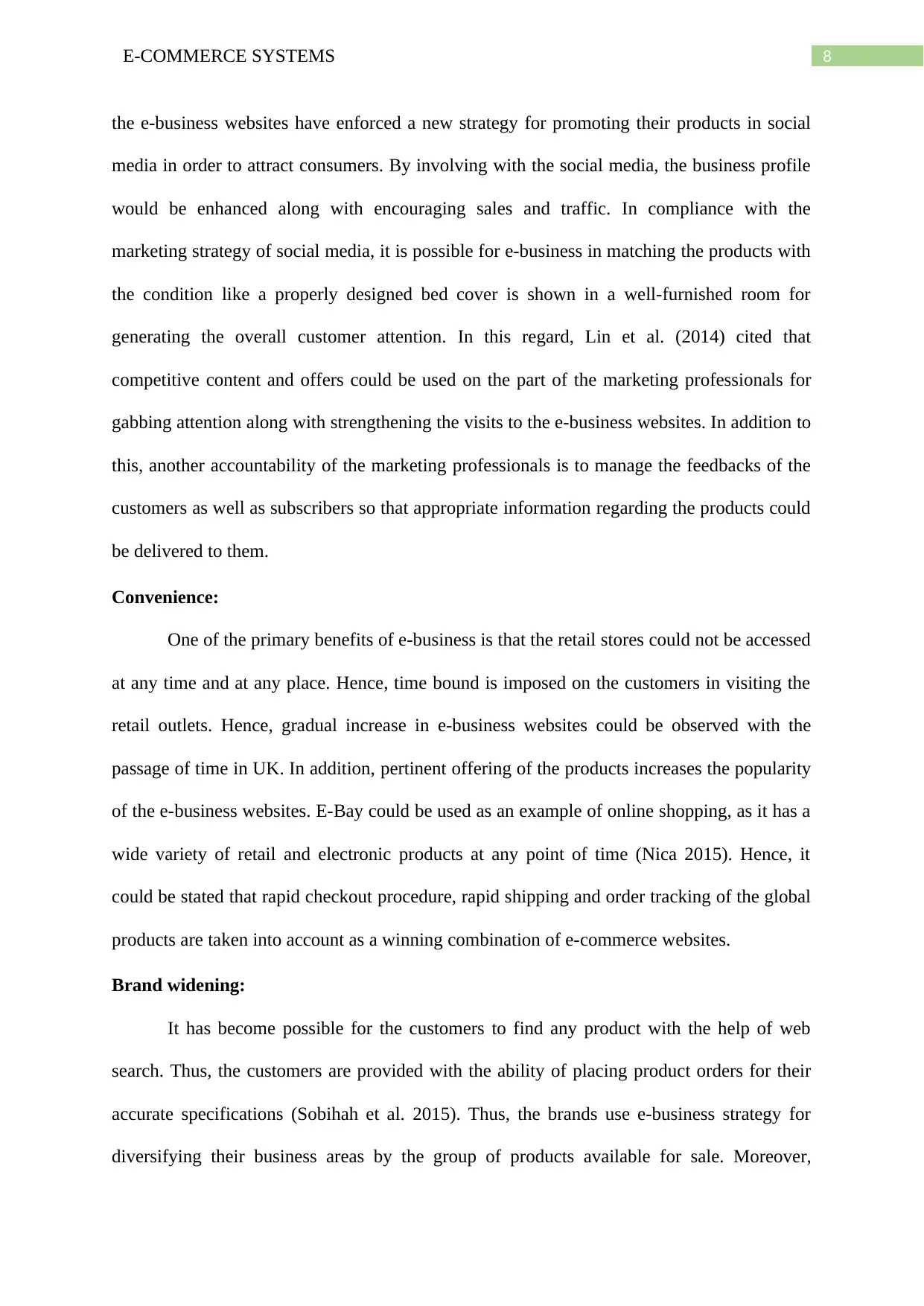
8E-COMMERCE SYSTEMS
the e-business websites have enforced a new strategy for promoting their products in social
media in order to attract consumers. By involving with the social media, the business profile
would be enhanced along with encouraging sales and traffic. In compliance with the
marketing strategy of social media, it is possible for e-business in matching the products with
the condition like a properly designed bed cover is shown in a well-furnished room for
generating the overall customer attention. In this regard, Lin et al. (2014) cited that
competitive content and offers could be used on the part of the marketing professionals for
gabbing attention along with strengthening the visits to the e-business websites. In addition to
this, another accountability of the marketing professionals is to manage the feedbacks of the
customers as well as subscribers so that appropriate information regarding the products could
be delivered to them.
Convenience:
One of the primary benefits of e-business is that the retail stores could not be accessed
at any time and at any place. Hence, time bound is imposed on the customers in visiting the
retail outlets. Hence, gradual increase in e-business websites could be observed with the
passage of time in UK. In addition, pertinent offering of the products increases the popularity
of the e-business websites. E-Bay could be used as an example of online shopping, as it has a
wide variety of retail and electronic products at any point of time (Nica 2015). Hence, it
could be stated that rapid checkout procedure, rapid shipping and order tracking of the global
products are taken into account as a winning combination of e-commerce websites.
Brand widening:
It has become possible for the customers to find any product with the help of web
search. Thus, the customers are provided with the ability of placing product orders for their
accurate specifications (Sobihah et al. 2015). Thus, the brands use e-business strategy for
diversifying their business areas by the group of products available for sale. Moreover,
the e-business websites have enforced a new strategy for promoting their products in social
media in order to attract consumers. By involving with the social media, the business profile
would be enhanced along with encouraging sales and traffic. In compliance with the
marketing strategy of social media, it is possible for e-business in matching the products with
the condition like a properly designed bed cover is shown in a well-furnished room for
generating the overall customer attention. In this regard, Lin et al. (2014) cited that
competitive content and offers could be used on the part of the marketing professionals for
gabbing attention along with strengthening the visits to the e-business websites. In addition to
this, another accountability of the marketing professionals is to manage the feedbacks of the
customers as well as subscribers so that appropriate information regarding the products could
be delivered to them.
Convenience:
One of the primary benefits of e-business is that the retail stores could not be accessed
at any time and at any place. Hence, time bound is imposed on the customers in visiting the
retail outlets. Hence, gradual increase in e-business websites could be observed with the
passage of time in UK. In addition, pertinent offering of the products increases the popularity
of the e-business websites. E-Bay could be used as an example of online shopping, as it has a
wide variety of retail and electronic products at any point of time (Nica 2015). Hence, it
could be stated that rapid checkout procedure, rapid shipping and order tracking of the global
products are taken into account as a winning combination of e-commerce websites.
Brand widening:
It has become possible for the customers to find any product with the help of web
search. Thus, the customers are provided with the ability of placing product orders for their
accurate specifications (Sobihah et al. 2015). Thus, the brands use e-business strategy for
diversifying their business areas by the group of products available for sale. Moreover,
⊘ This is a preview!⊘
Do you want full access?
Subscribe today to unlock all pages.

Trusted by 1+ million students worldwide
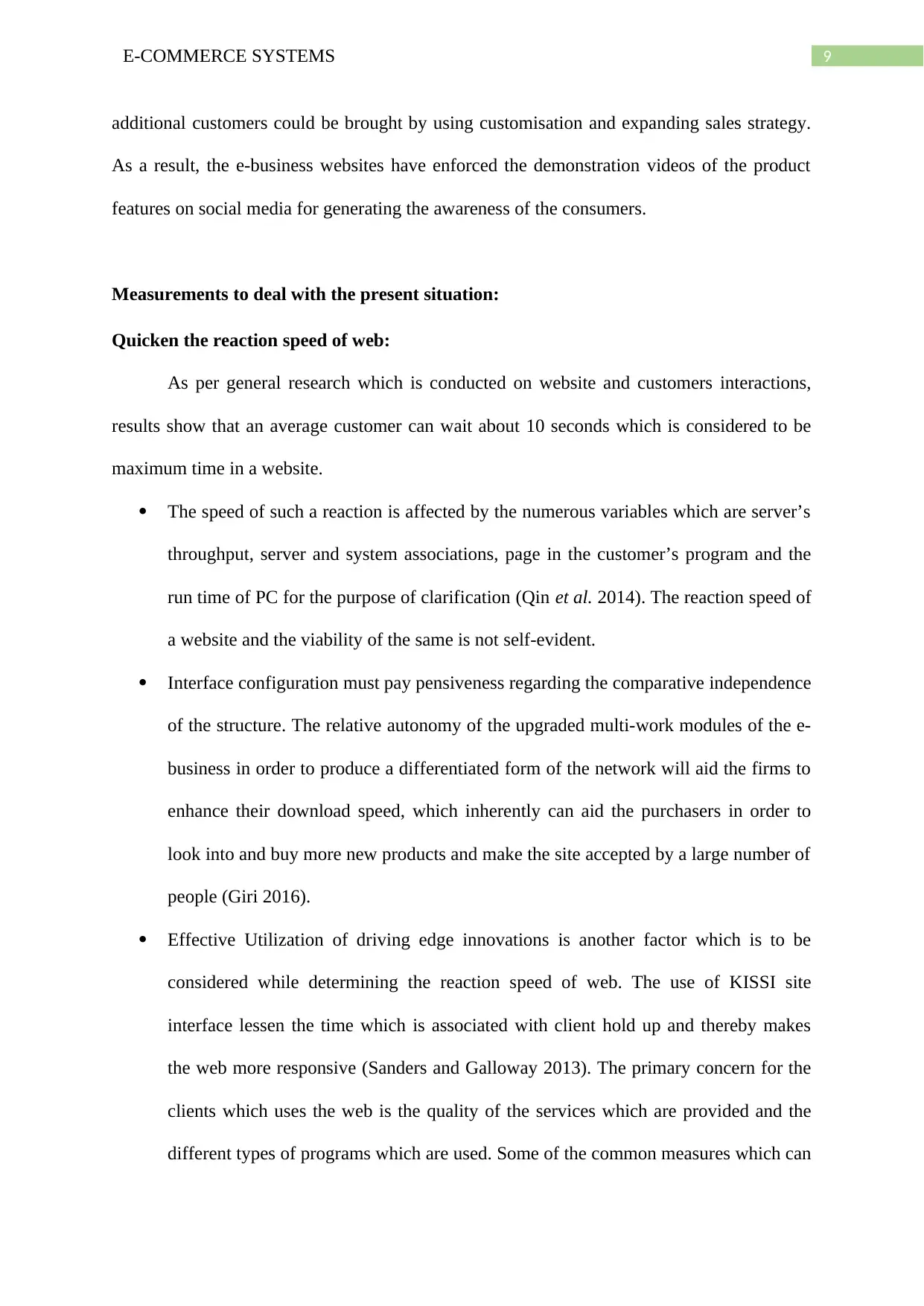
9E-COMMERCE SYSTEMS
additional customers could be brought by using customisation and expanding sales strategy.
As a result, the e-business websites have enforced the demonstration videos of the product
features on social media for generating the awareness of the consumers.
Measurements to deal with the present situation:
Quicken the reaction speed of web:
As per general research which is conducted on website and customers interactions,
results show that an average customer can wait about 10 seconds which is considered to be
maximum time in a website.
The speed of such a reaction is affected by the numerous variables which are server’s
throughput, server and system associations, page in the customer’s program and the
run time of PC for the purpose of clarification (Qin et al. 2014). The reaction speed of
a website and the viability of the same is not self-evident.
Interface configuration must pay pensiveness regarding the comparative independence
of the structure. The relative autonomy of the upgraded multi-work modules of the e-
business in order to produce a differentiated form of the network will aid the firms to
enhance their download speed, which inherently can aid the purchasers in order to
look into and buy more new products and make the site accepted by a large number of
people (Giri 2016).
Effective Utilization of driving edge innovations is another factor which is to be
considered while determining the reaction speed of web. The use of KISSI site
interface lessen the time which is associated with client hold up and thereby makes
the web more responsive (Sanders and Galloway 2013). The primary concern for the
clients which uses the web is the quality of the services which are provided and the
different types of programs which are used. Some of the common measures which can
additional customers could be brought by using customisation and expanding sales strategy.
As a result, the e-business websites have enforced the demonstration videos of the product
features on social media for generating the awareness of the consumers.
Measurements to deal with the present situation:
Quicken the reaction speed of web:
As per general research which is conducted on website and customers interactions,
results show that an average customer can wait about 10 seconds which is considered to be
maximum time in a website.
The speed of such a reaction is affected by the numerous variables which are server’s
throughput, server and system associations, page in the customer’s program and the
run time of PC for the purpose of clarification (Qin et al. 2014). The reaction speed of
a website and the viability of the same is not self-evident.
Interface configuration must pay pensiveness regarding the comparative independence
of the structure. The relative autonomy of the upgraded multi-work modules of the e-
business in order to produce a differentiated form of the network will aid the firms to
enhance their download speed, which inherently can aid the purchasers in order to
look into and buy more new products and make the site accepted by a large number of
people (Giri 2016).
Effective Utilization of driving edge innovations is another factor which is to be
considered while determining the reaction speed of web. The use of KISSI site
interface lessen the time which is associated with client hold up and thereby makes
the web more responsive (Sanders and Galloway 2013). The primary concern for the
clients which uses the web is the quality of the services which are provided and the
different types of programs which are used. Some of the common measures which can
Paraphrase This Document
Need a fresh take? Get an instant paraphrase of this document with our AI Paraphraser
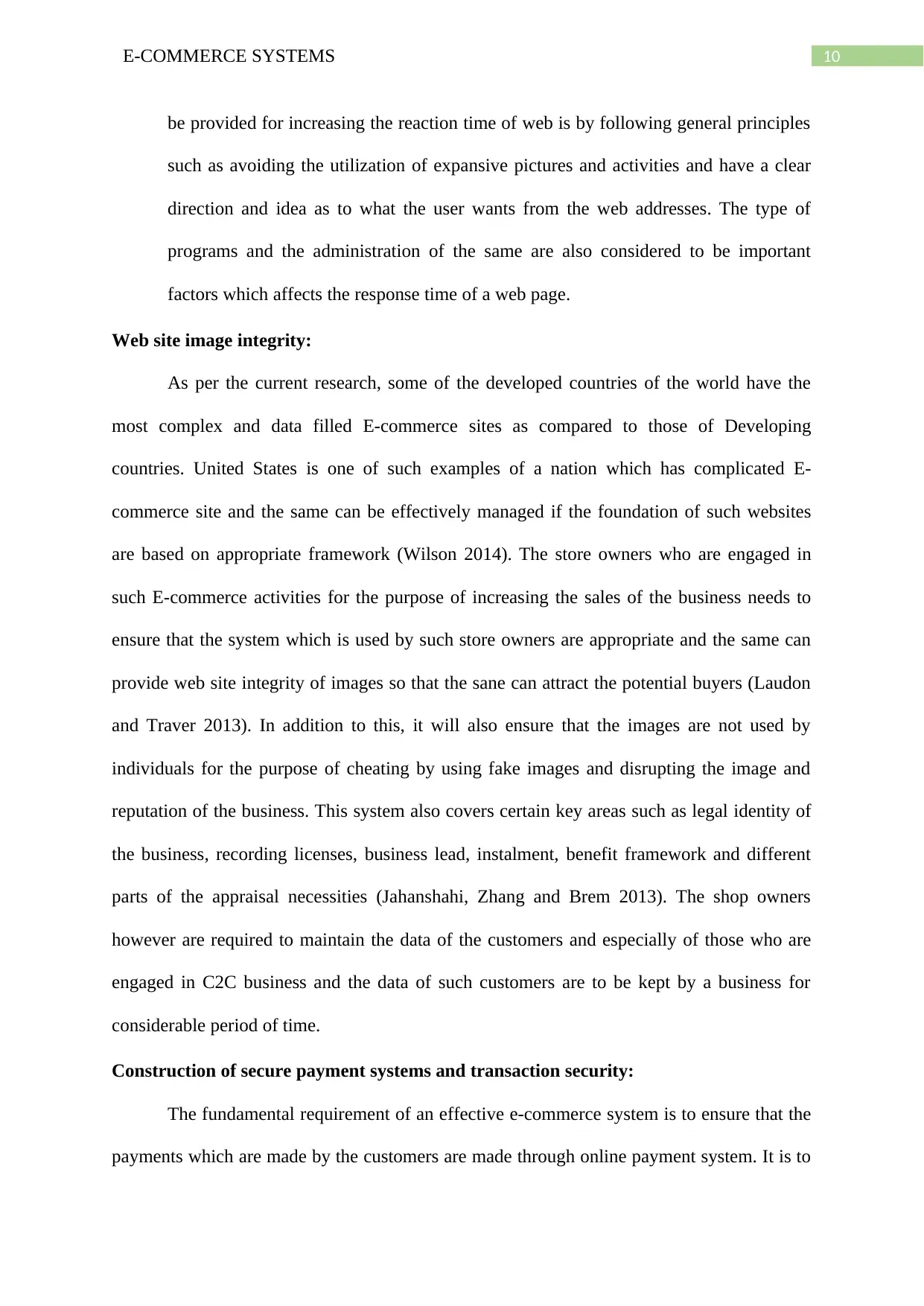
10E-COMMERCE SYSTEMS
be provided for increasing the reaction time of web is by following general principles
such as avoiding the utilization of expansive pictures and activities and have a clear
direction and idea as to what the user wants from the web addresses. The type of
programs and the administration of the same are also considered to be important
factors which affects the response time of a web page.
Web site image integrity:
As per the current research, some of the developed countries of the world have the
most complex and data filled E-commerce sites as compared to those of Developing
countries. United States is one of such examples of a nation which has complicated E-
commerce site and the same can be effectively managed if the foundation of such websites
are based on appropriate framework (Wilson 2014). The store owners who are engaged in
such E-commerce activities for the purpose of increasing the sales of the business needs to
ensure that the system which is used by such store owners are appropriate and the same can
provide web site integrity of images so that the sane can attract the potential buyers (Laudon
and Traver 2013). In addition to this, it will also ensure that the images are not used by
individuals for the purpose of cheating by using fake images and disrupting the image and
reputation of the business. This system also covers certain key areas such as legal identity of
the business, recording licenses, business lead, instalment, benefit framework and different
parts of the appraisal necessities (Jahanshahi, Zhang and Brem 2013). The shop owners
however are required to maintain the data of the customers and especially of those who are
engaged in C2C business and the data of such customers are to be kept by a business for
considerable period of time.
Construction of secure payment systems and transaction security:
The fundamental requirement of an effective e-commerce system is to ensure that the
payments which are made by the customers are made through online payment system. It is to
be provided for increasing the reaction time of web is by following general principles
such as avoiding the utilization of expansive pictures and activities and have a clear
direction and idea as to what the user wants from the web addresses. The type of
programs and the administration of the same are also considered to be important
factors which affects the response time of a web page.
Web site image integrity:
As per the current research, some of the developed countries of the world have the
most complex and data filled E-commerce sites as compared to those of Developing
countries. United States is one of such examples of a nation which has complicated E-
commerce site and the same can be effectively managed if the foundation of such websites
are based on appropriate framework (Wilson 2014). The store owners who are engaged in
such E-commerce activities for the purpose of increasing the sales of the business needs to
ensure that the system which is used by such store owners are appropriate and the same can
provide web site integrity of images so that the sane can attract the potential buyers (Laudon
and Traver 2013). In addition to this, it will also ensure that the images are not used by
individuals for the purpose of cheating by using fake images and disrupting the image and
reputation of the business. This system also covers certain key areas such as legal identity of
the business, recording licenses, business lead, instalment, benefit framework and different
parts of the appraisal necessities (Jahanshahi, Zhang and Brem 2013). The shop owners
however are required to maintain the data of the customers and especially of those who are
engaged in C2C business and the data of such customers are to be kept by a business for
considerable period of time.
Construction of secure payment systems and transaction security:
The fundamental requirement of an effective e-commerce system is to ensure that the
payments which are made by the customers are made through online payment system. It is to
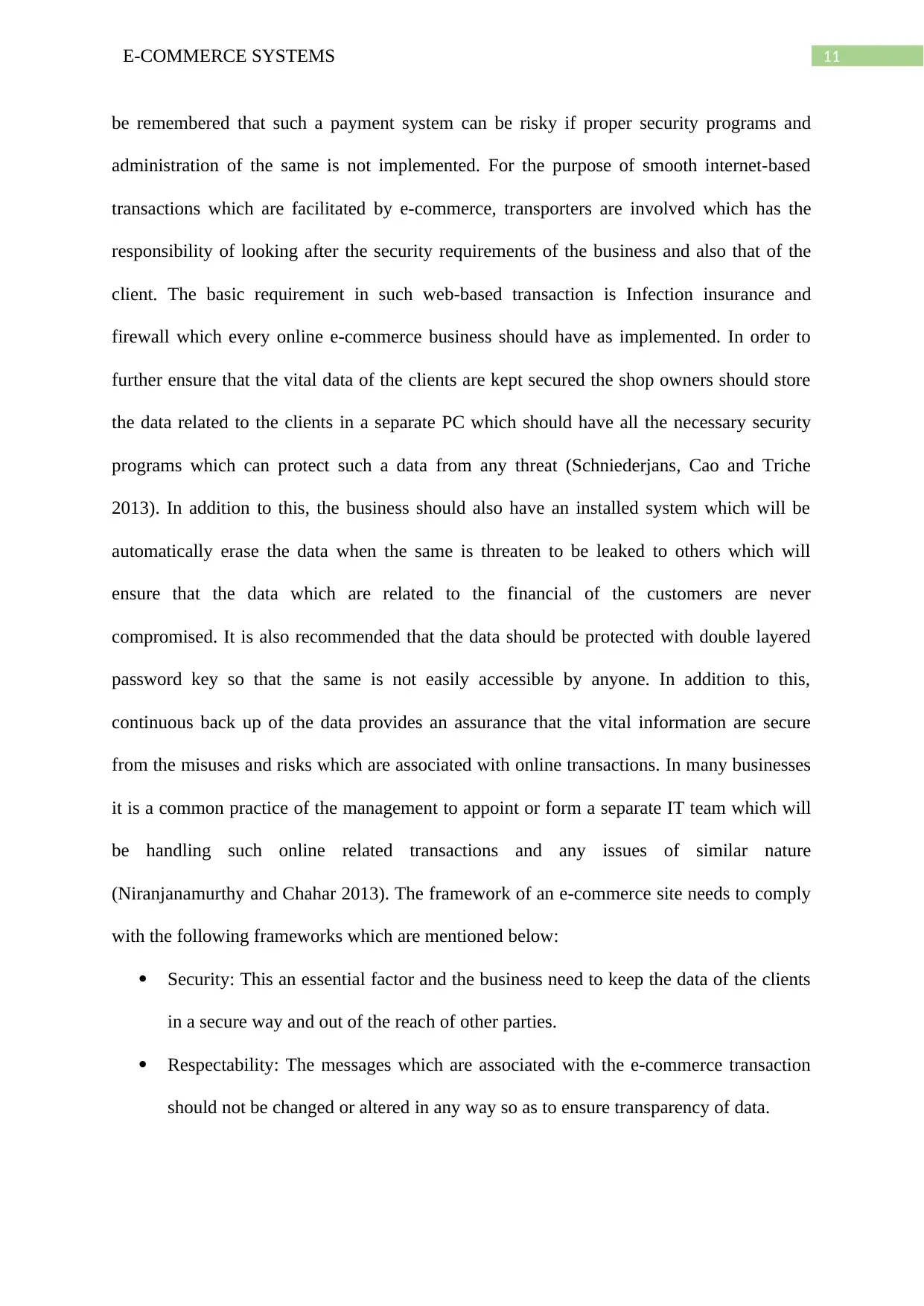
11E-COMMERCE SYSTEMS
be remembered that such a payment system can be risky if proper security programs and
administration of the same is not implemented. For the purpose of smooth internet-based
transactions which are facilitated by e-commerce, transporters are involved which has the
responsibility of looking after the security requirements of the business and also that of the
client. The basic requirement in such web-based transaction is Infection insurance and
firewall which every online e-commerce business should have as implemented. In order to
further ensure that the vital data of the clients are kept secured the shop owners should store
the data related to the clients in a separate PC which should have all the necessary security
programs which can protect such a data from any threat (Schniederjans, Cao and Triche
2013). In addition to this, the business should also have an installed system which will be
automatically erase the data when the same is threaten to be leaked to others which will
ensure that the data which are related to the financial of the customers are never
compromised. It is also recommended that the data should be protected with double layered
password key so that the same is not easily accessible by anyone. In addition to this,
continuous back up of the data provides an assurance that the vital information are secure
from the misuses and risks which are associated with online transactions. In many businesses
it is a common practice of the management to appoint or form a separate IT team which will
be handling such online related transactions and any issues of similar nature
(Niranjanamurthy and Chahar 2013). The framework of an e-commerce site needs to comply
with the following frameworks which are mentioned below:
Security: This an essential factor and the business need to keep the data of the clients
in a secure way and out of the reach of other parties.
Respectability: The messages which are associated with the e-commerce transaction
should not be changed or altered in any way so as to ensure transparency of data.
be remembered that such a payment system can be risky if proper security programs and
administration of the same is not implemented. For the purpose of smooth internet-based
transactions which are facilitated by e-commerce, transporters are involved which has the
responsibility of looking after the security requirements of the business and also that of the
client. The basic requirement in such web-based transaction is Infection insurance and
firewall which every online e-commerce business should have as implemented. In order to
further ensure that the vital data of the clients are kept secured the shop owners should store
the data related to the clients in a separate PC which should have all the necessary security
programs which can protect such a data from any threat (Schniederjans, Cao and Triche
2013). In addition to this, the business should also have an installed system which will be
automatically erase the data when the same is threaten to be leaked to others which will
ensure that the data which are related to the financial of the customers are never
compromised. It is also recommended that the data should be protected with double layered
password key so that the same is not easily accessible by anyone. In addition to this,
continuous back up of the data provides an assurance that the vital information are secure
from the misuses and risks which are associated with online transactions. In many businesses
it is a common practice of the management to appoint or form a separate IT team which will
be handling such online related transactions and any issues of similar nature
(Niranjanamurthy and Chahar 2013). The framework of an e-commerce site needs to comply
with the following frameworks which are mentioned below:
Security: This an essential factor and the business need to keep the data of the clients
in a secure way and out of the reach of other parties.
Respectability: The messages which are associated with the e-commerce transaction
should not be changed or altered in any way so as to ensure transparency of data.
⊘ This is a preview!⊘
Do you want full access?
Subscribe today to unlock all pages.

Trusted by 1+ million students worldwide
1 out of 16
Related Documents
Your All-in-One AI-Powered Toolkit for Academic Success.
+13062052269
info@desklib.com
Available 24*7 on WhatsApp / Email
![[object Object]](/_next/static/media/star-bottom.7253800d.svg)
Unlock your academic potential
Copyright © 2020–2025 A2Z Services. All Rights Reserved. Developed and managed by ZUCOL.





